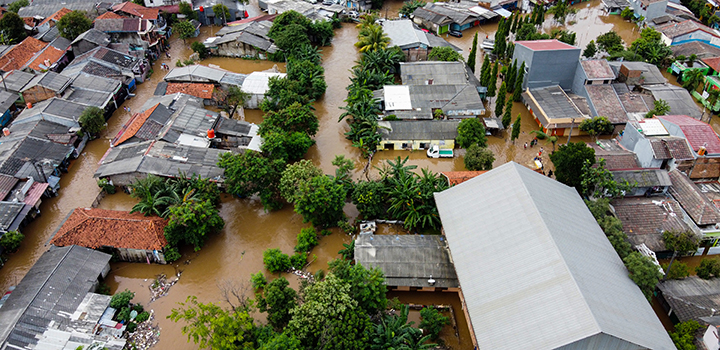Scientists warn rising global temperatures spell high flood risk for river basins
- February 3, 2022
- Posted by: Elaine Coles
- Category: Agriculture, Environmental, Global, Research Papers, Water Issues, Africa, Asia

River basins around the world are vulnerable to increased flood danger from rising global temperatures, according to new research from the University of East Anglia (UEA).
The comprehensive study shows even a modest temperature increase of 1.5°C will spell significant risks for parts of India, China, Ethiopia, Ghana, Brazil and Egypt, the countries for which the team modelled data.
The findings, ‘Quantifications of impacts between 1.5°C and 4°C of global warming on flood risks in six countries’, are published in Climatic Change.
The team, led by Dr Yi He and her colleagues in the Tyndall Centre for Climate Change at UEA, looked at fluvial flood risks for six global warming levels between 1.5 and 4°C by 2100. The study examined six countries all considered to be vulnerable to climate change, selected from different continents, spanning different levels of development and ranging considerably in size.
Several previous studies have focused on global scale projections of changes in flood frequency under climate change. This study aims to quantify flood risks due to global warming and make the results comparable at the country level by using a consistent set of models, climate scenarios, baseline and future time periods, and hazard metrics. The method could be applied to other countries in the future.
Daily time series of precipitation, temperature and monthly potential evapotranspiration were generated by combining monthly observations, daily reanalysis data, and projected changes in the five CMIP5 (Coupled Model Intercomparison Project Phase 5, Global Climate Models).
These series were then used to drive the hydrological and hydrodynamic models to simulate river discharge and flood inundation.
Dr He, an Associate Professor in Hydrology & Climate Change Research in UEA’s School of Environmental Sciences, led the study. She said:
“Our results indicate that return periods of one-in-100-year floods in the late 20th century are likely to decrease with warming, meaning an increased number of people will be exposed to flood risks, particularly with 4°C warming.
“Exposure in the major river basin areas in the six countries increases significantly, ranging from a doubling in China to more than 50-fold in Egypt.
“Limiting warming to 1.5°C would decrease the risks, resulting in increases ranging from 12% in China to around 13-fold in Egypt.”
A one-in-100-year flood event is defined as an event of a size that will be equalled or exceeded on average once every 100 years. That is, over a period of 1,000 years, a one-in-100-year event would expect to be equalled or exceeded ten times.
That doesn’t mean such floods only occur at that frequency, and experts believe climate change is leading to more frequent large floods, the likes of which have struck parts of Britain, Germany, the United States, Australia and China in recent years, due to record-breaking or heavy, sustained rainfall.
With global warming heating the oceans and the atmosphere, the hydrological cycle intensifies. With the atmosphere holding more water as temperatures rise, researchers expect increasing intense and sustained rainfall events.
Such floods also can result from land clearing or other habitat changes to the area around flood plains, including development and human population increases.
Nearly 1 billion people live in floodplains, and although population models can’t predict exactly how many will live in those areas toward the end of the century, any increase in global temperatures poses a severe threat to life.
The study did not consider glacier runoff and snow melt in mountainous regions, which could be added to the modelling chain of future studies to account for glacier changes and the impacts on water resources due to global warming.
Quantification of flood risk is uncertain even in the absence of climate change. More studies are needed to provide more estimates, and the flood modelling community needs to agree on a common platform to make results comparable.
The study, ‘Quantifications of impacts between 1.5°C and 4°C of global warming on flood risks in six countries’, was published in Climatic Change on 25 January 2022.
